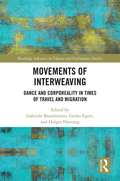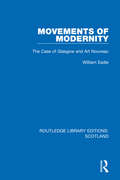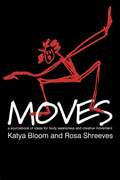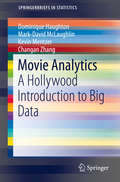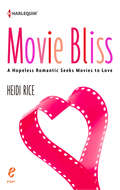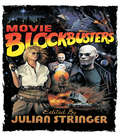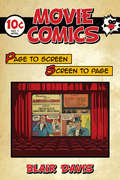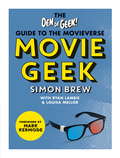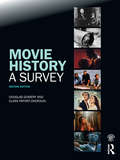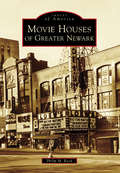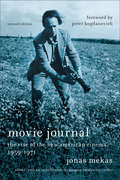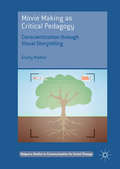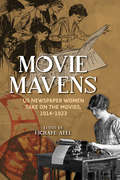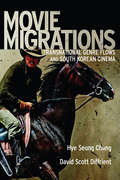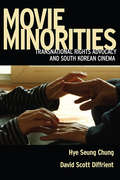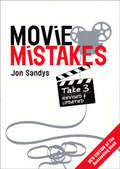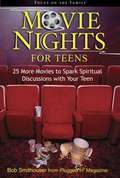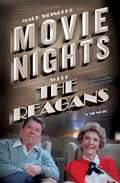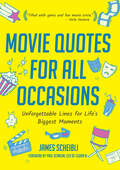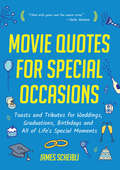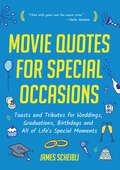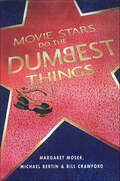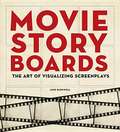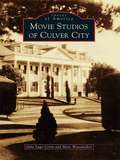- Table View
- List View
Movements of Interweaving: Dance and Corporeality in Times of Travel and Migration (Routledge Advances in Theatre & Performance Studies)
by Gabriele Brandstetter Gerko Egert Holger HartungMovements of Interweaving is a rich collection of essays exploring the concept of interweaving performance cultures in the realms of movement, dance, and corporeality. Focusing on dance performances as well as on scenarios of cultural movements on a global scale, it not only challenges the concept of intercultural dance performances, but through its innovative approach also calls attention to the specific qualities of "interweaving" as a form of movement itself. Divided into four sections, this volume features an international team of scholars together developing a new critical perspective on the cultural practices of movement, travel and migration in and beyond dance.
Movements of Modernity: The Case of Glasgow and Art Nouveau (Routledge Library Editions: Scotland #11)
by William EadieOriginally published in 1990, acknowledges the social as well as the artistic significance of the Glasgow Art Nouveau movement by examining the history of it from its inception through to its demise. By considering the contributions of social theorists like Peter Bürger, Theodor Adorno, and Walter Benjamin, the author illustrates how Art nouveau can be located within an avant-garde. The book also reveals to what extent the contract which the Glasgow group had with the Secessionists in Vienna was significant for the development of their work.
Moves: A Sourcebook of Ideas for Body Awareness and Creative Movement
by Katya Bloom Rosa ShreevesFirst Published in 1998. The aim of this book is to reawaken awareness of the body feels; rekindle imagination; provide starting points for both developing greater self-awareness and creating expressive movement. 'Moves' suggests a wealth of exercises which stem from the natural movement of the body and are therefore accessible to anyone. As you respond to the material in this book you may notice changes in yourself, such as greater physical and emotional freedom, a lessening of anxiety and constriction, a new found sense of flow, flexibility and strength and a greater responsiveness to others and to the environment.
Movie Analytics
by Dominique Haughton Mark-David Mclaughlin Kevin Mentzer Changan ZhangMovies will never be the same after you learn how to analyze movie data, including key data mining, text mining and social network analytics concepts. These techniques may then be used in endless other contexts. In the movie application, this topic opens a lively discussion on the current developments in big data from a data science perspective. This book is geared to applied researchers and practitioners and is meant to be practical. The reader will take a hands-on approach, running text mining and social network analyses with software packages covered in the book. These include R, SAS, Knime, Pajek and Gephi. The nitty-gritty of how to build datasets needed for the various analyses will be discussed as well. This includes how to extract suitable Twitter data and create a co-starring network from the IMDB database given memory constraints. The authors also guide the reader through an analysis of movie attendance data via a realistic dataset from France.
Movie Bliss: A Hopeless Romantic Seeks Movies to Love
by Heidi RiceThe Romance Lover's Guide to Movie Must-Sees. If you adore Sleepless in Seattle and Pride and Prejudice and The Avengers, then you want a movie guide aimed at women like you. Women who enjoy romances and more! You like both a good kiss and a good knockout and refuse to be categorized-but you wish someone like you would recommend movies.Which brings Harlequin author and professional movie critic Heidi Rice to the rescue. Whether it's nonstop action with a little heart 'n' soul, sweetly adorable cartoons, a classic black-and-white screwball comedy or that under-the-radar flick that you never knew you were missing, Heidi Rice will lead you through her must-sees and why you will also enjoy them. From Ryan Gosling's six-pack to that iconic orgasm sandwich delivered by Meg Ryan, right up to the double whammy of hotties in Prisoners (Gyllenhaal and Jackman)-there's a little something for everyone.And a little something for that teenager inside you who's ready to watch "nekkid" man-candy and spend two hours falling in love all over again....
Movie Blockbusters
by Julian StringerBig-budget, spectacular films designed to appeal to a mass audience: is this what - or all - blockbusters are? Movie Blockbusters brings together writings from key film scholars, including Douglas Gomery, Peter Kramer, Jon Lewis and Steve Neale, to address the work of notable blockbuster auteurs such as Steven Spielberg and James Cameron, discuss key movies such as Star Wars and Titanic, and consider the context in which blockbusters are produced and consumed, including what the rise of the blockbuster says about the Hollywood film industry, how blockbusters are marketed and exhibited, and who goes to see them. The book also considers the movie scene outside Hollywood, discussing blockbusters made in Bollywood, China, South Korea, New Zealand and Argentina
Movie Comics: Page to Screen/Screen to Page
by Blair DavisAs Christopher Nolan’s Batman films and releases from the Marvel Cinematic Universe have regularly topped the box office charts, fans and critics alike might assume that the “comic book movie” is a distinctly twenty-first-century form. Yet adaptations of comics have been an integral part of American cinema from its very inception, with comics characters regularly leaping from the page to the screen and cinematic icons spawning comics of their own. Movie Comics is the first book to study the long history of both comics-to-film and film-to-comics adaptations, covering everything from silent films starring Happy Hooligan to sound films and serials featuring Dick Tracy and Superman to comic books starring John Wayne, Gene Autry, Bob Hope, Abbott & Costello, Alan Ladd, and Dean Martin and Jerry Lewis. With a special focus on the Classical Hollywood era, Blair Davis investigates the factors that spurred this media convergence, as the film and comics industries joined forces to expand the reach of their various brands. While analyzing this production history, he also tracks the artistic coevolution of films and comics, considering the many formal elements that each medium adopted and adapted from the other. As it explores our abiding desire to experience the same characters and stories in multiple forms, Movie Comics gives readers a new appreciation for the unique qualities of the illustrated page and the cinematic moving image.
Movie Geek: The Den of Geek Guide to the Movieverse
by Simon Brew Den Of GeekMovie Geek is a nerdy dive into popular movies, brought to you by the award-losing Den Of Geek website, with a foreword by the UK's foremost film critic, Mark Kermode. Discover hidden stories behind movies you love (and, er, don't love so much), and find out just why the most dangerous place to be is in a Tom Hanks film.Fascinating, surprisingly and hugely entertaining, this leftfield movie guide is gold for film buffs, and might just bring out the geek - hidden or otherwise - within you...Includes:Alternative movie endings that were binned Movie sequels you didn't know existedMassive box office hits that were huge gamblesThe collateral damage of Tom Hanks moviesHidden subtexts in family moviesDisastrous things that went wrong on modern movie sets...and much, much more!
Movie Geek: The Den of Geek Guide to the Movieverse
by Simon Brew Den of GeekA comprehensive compendium of cult website Den of Geek's most popular articles combined with new material to create the ultimate alternative encyclopedia of film.
Movie History: Second Edition
by Douglas Gomery Clara Pafort-OverduinCovering everything from Edison to Avatar, Gomery and Pafort-Overduin have written the clearest, best organized, and most user-friendly film history textbook on the market. It masterfully distills the major trends and movements of film history, so that the subject can be taught in one semester. And each chapter includes a compelling case study that highlights an important moment in movie history and, at the same time, subtly introduces a methodological approach. This book is a pleasure to read and to teach. Peter Decherney, University of Pennsylvania, USA In addition to providing a comprehensive overview of the development of film around the world, the book gives us examples of how to do film history, including organizing the details and discussing their implications.Hugh McCarney, Western Connecticut State University, USA Douglas Gomery and Clara Pafort-Overduin have created an outstanding textbook with an impressive breadth of content, covering over 100 years in the evolution of cinema. Movie History: A Survey is an engaging book that will reward readers with a contemporary perspective of the history of motion pictures and provide a solid foundation for the study of film. Matthew Hanson, Eastern Michigan University, USA How can we understand the history of film? Historical facts don’t answer the basic questions of film history. History, as this fascinating book shows, is more than the simple accumulation of film titles, facts and figures. This is a survey of over 100 years of cinema history, from its beginnings in 1895, to its current state in the twenty-first century. An accessible, introductory text, Movie History: A Survey looks at not only the major films, filmmakers, and cinema institutions throughout the years, but also extends to the production, distribution, exhibition, technology and reception of films. The textbook is divided chronologically into four sections, using the timeline of technological changes: Section One looks at the era of silent movies from 1895 to 1927; Section Two starts with the coming of sound and covers 1928 until 1950; Section Three runs from 1951 to 1975 and deals with the coming and development of television; and Section Four focuses on the coming of home video and the transition to digital, from 1975 to 2010. Key pedagogical features include: timelines in each section help students to situate the films within a broader historical context case study boxes with close-up analysis of specific film histories and a particular emphasis on film reception lavishly illustrated with over 450 color images to put faces to names, and to connect pictures to film titles margin notes add background information and clarity glossary for clear understanding of the key terms described references and further reading at the end of each chapter to enhance further study. A supporting website is available at www.routledge.com/textbooks/moviehistory, with lots of extra materials, useful for the classroom or independent study, including: additional case studies – new, in-depth and unique to the website international case studies – for the Netherlands in Dutch and English timeline - A movie history timeline charting key dates in the history of cinema from 1890 to the present day revision flash cards – ideal for getting to grips with key terms in film studies related resources – on the website you will find every link from the book for ease of use, plus access to additional online material students are also invited to submit their own movie history case studies - see website for details Written by two highly respected film scholars and experienced teachers, Movie History is the ideal textbook for students studying film history.
Movie Houses of Greater Newark (Images of America)
by Philip M. ReadFor decades, Newark and its environs have been lit up by the bright neon lights of grand movie palaces and theaters. In the early 20th century, stages that were originally built for vaudeville acts were turned over to silver screens and the flickering images from motion-picture projectors. This new technology ushered Hollywood movies to the East Coast and made cinema accessible for locals to enjoy. Movie houses and palaces provided moviegoers a new type of viewing experience. With ornate interiors and rich architecture, these institutions offered their patrons a beautiful setting to watch classic films. Over time, these establishments evolved and began hosting burlesque shows and rock concerts. Today, many of these downtown landmarks have been demolished, replaced, or adaptively renovated into the modern multiplexes of today. Images of the Paramount and the Mosque Theater help Movie Houses of Greater Newark tell the story of an era when going to the movies was an event.
Movie Journal: The Rise of the New American Cinema, 1959-1971 (Film and Culture Series)
by Jonas MekasIn his Village Voice "Movie Journal" columns, Jonas Mekas captured the makings of an exciting movement in 1960s American filmmaking. Works by Andy Warhol, Gregory J. Markapoulos, Stan Brakhage, Jack Smith, Robert Breer, and others echoed experiments already underway elsewhere, yet they belonged to a nascent tradition that only a true visionary could identify. Mekas incorporated the most essential characteristics of these films into a unique conception of American filmmaking's next phase. He simplified complex aesthetic strategies for unfamiliar audiences and appreciated the subversive genius of films that many dismissed as trash. This new edition presents Mekas's original critiques in full, with additional material on the filmmakers, film studies scholars, and popular and avant-garde critics whom he inspired and transformed.
Movie Making as Critical Pedagogy: Conscientization Through Visual Storytelling (Palgrave Studies In Communication For Social Change)
by Grady WalkerCan the stories people tell influence the way they see the world? This book seeks to address that question through a study of the viability of movie making as a critical pedagogy activity. Positioned at the intersection of education and communication for social change, it explores the relationship between the generation of subjective knowledge through storytelling and analysis, and systemic change. Central to the book is a case study from Nepal. By using video as the action element and analytical material of coursework, youth participants generated a new critical awareness, engendered by themes arising from group discussion. Through the analysis of these themes participants initiated an emergence known as conscientization. Led by two critical educators, participants used the production, screening, and analysis of their own movies to propel the course, or praxis, forward. This book seeks to inform the practice of critical pedagogy both practically and theoretically, and also offers a contribution to the fields of participatory action-research and communication for social change.
Movie Mavens: US Newspaper Women Take On the Movies, 1914-1923 (Women & Film History International)
by Dorothy Day Janet Flanner Kitty Kelly Genevieve Harris Virginia Dale Grace Kingsley Charlotta Bass Louella O. Parsons Esther Hoffman The Film Girl" Mildred Joclyn Oma Moody Lawrence Mae Tinee Charlotte S. Kelly Marjorie Daw Virginia Tracy Rae McRae Harriette Underhill Alberta HartleyDuring the early era of cinema, moviegoers turned to women editors and writers for the latest on everyone's favorite stars, films, and filmmakers. Richard Abel returns these women to film history with an anthology of reviews, articles, and other works. Drawn from newspapers of the time, the selections show how columnists like Kitty Kelly, Mae Tinee, Louella Parsons, and Genevieve Harris wrote directly to female readers. They also profiled women working in jobs like scenario writer and film editor and noted the industry's willingness to hire women. Sharp wit and frank opinions entertained and informed a wide readership hungry for news about the movies but also about women on both sides of the camera. Abel supplements the texts with hard-to-find biographical information and provides context on the newspapers and silent-era movie industry as well as on the professionals and films highlighted by these writers. An invaluable collection of rare archival sources, Movie Mavens reveals women's essential contribution to the creation of American film culture.
Movie Migrations
by David Scott Diffrient Hye Seung ChungAs the two billion YouTube views for "Gangnam Style" would indicate, South Korean popular culture has begun to enjoy new prominence on the global stage. Yet, as this timely new study reveals, the nation's film industry has long been a hub for transnational exchange, producing movies that put a unique spin on familiar genres, while influencing world cinema from Hollywood to Bollywood. Movie Migrations is not only an introduction to one of the world's most vibrant national cinemas, but also a provocative call to reimagine the very concepts of "national cinemas" and "film genre." Challenging traditional critical assumptions that place Hollywood at the center of genre production, Hye Seung Chung and David Scott Diffrient bring South Korean cinema to the forefront of recent and ongoing debates about globalization and transnationalism. In each chapter they track a different way that South Korean filmmakers have adapted material from foreign sources, resulting in everything from the Manchurian Western to The Host's reinvention of the Godzilla mythos. Spanning a wide range of genres, the book introduces readers to classics from the 1950s and 1960s Golden Age of South Korean cinema, while offering fresh perspectives on recent favorites like Oldboy and Thirst. Perfect not only for fans of Korean film, but for anyone curious about media in an era of globalization, Movie Migrations will give readers a new appreciation for the creative act of cross-cultural adaptation.
Movie Minorities: Transnational Rights Advocacy and South Korean Cinema
by David Scott Diffrient Hye Seung ChungRights advocacy has become a prominent facet of South Korea’s increasingly transnational motion picture output, especially following the 1998 presidential inauguration of Kim Dae-jung, a former political prisoner and victim of human rights abuses who received the Nobel Peace Prize in 2000. Today it is not unusual to see a big-budget production about the pursuit of social justice or the protection of civil liberties contending for the top spot at the box office. With that cultural shift has come a diversification of film subjects, which range from undocumented workers’ rights to the sexual harassment experienced by women to high-school bullying to the struggles among people with disabilities to gain inclusion within a society that has transformed significantly since winning democratic freedoms three decades ago. Combining in-depth textual analyses of films such as Bleak Night, Okja, Planet of Snail, Repatriation, and Silenced with broader historical contextualization, Movie Minorities offers the first English-language study of South Korean cinema’s role in helping to galvanize activist social movements across several identity-based categories.
Movie Mistakes: Take 3
by Jon SandysEver noticed a digital watch in a historical film? Or seen a camera crew in a mirror?There's nothing we like more than finding a continuity error, a historical inaccuracy or a technical blunder. This third edition of the bestselling Movie Mistakes brings you over a thousand slip-ups to look out for.
Movie Nights for Teens: 25 More Movies To Spark Spirtiual Discussions With Your Teen
by Bob SmithouserThis book offers 25 movie suggestions for "date nights" for parents and teens. Each selection includes information about the movie, story summary, and cautions for parents. also, includes discussion questions.
Movie Nights with the Reagans: A Memoir
by Mark WeinbergFormer special advisor and press secretary to President Ronald Reagan shares an intimate, behind-the-scenes look inside the Reagan presidency—told through the movies they watched together every week at Camp David.What did President Ronald Reagan think of Rocky IV? How did the Matthew Broderick film WarGames inform America’s missile defense system? What Michael J. Fox movie made such an impression on President Reagan that he felt compelled to mention it in a speech to the Joint Session of Congress? Over the course of eight years, Mark Weinberg travelled to Camp David each weekend with Ronald and Nancy Reagan. He was one of a few select members invited into the Aspen Lodge, where the First Family screened both contemporary and classic movies on Friday and Saturday nights. They watched movies in times of triumph, such as the aftermath of Reagan’s 1984 landslide, and after moments of tragedy, such as the explosion of the Challenger and the shooting of the President and Press Secretary Jim Brady. Weinberg’s unparalleled access offers a rare glimpse of the Reagans—unscripted, relaxed, unburdened by the world, with no cameras in sight. Each chapter discusses a legendary film, what the Reagans thought of it, and provides warm anecdotes and untold stories about his family and the administration. From Reagan’s pranks on the Secret Service to his thoughts on the parallels between Hollywood and Washington, Weinberg paints a full picture of the president The New Yorker once famously dubbed “The Unknowable.” Movie Nights with the Reagans is a nostalgic journey through the 1980s and its most iconic films, seen through the eyes of one of Hollywood’s former stars: one who was simultaneously transforming the Republican Party, the American economy, and the course of the Cold War.
Movie Quotes for All Occasions: Unforgettable Lines for Life's Biggest Moments
by James ScheibliFind a film quotation for any situation in this collection that’s “full of gems” (Varla Ventura, author of The Book of the Bizarre).From Rhett Butler to Obi-Wan Kenobi, movie quotes have become an integral part of the way we express ourselves. This book gathers great lines with a purpose in mind: finding the right words to toast, celebrate, motivate, or comfort during the important occasions in our lives—whether it’s a wedding, a big game, a memorial service, a graduation, or a workplace event.Moving, inspiring, or just plain funny, you’ll find lots of options—or you can just enjoy reading—with this volume that also includes plenty of trivia and viewing suggestions for movie lovers.
Movie Quotes for Special Occasions: Toasts and Tributes for Weddings, Graduations, Birthdays and All of Life's Special Moments
by James ScheibliFilm buffs—find the perfect words for any special occasion in this handy movie quotation reference guide.Whether it’s Casablanca, Cabaret, Clueless, or The Cable Guy, you probably have favorite flicks you often quote. And it’s true, “We’ll always have Paris.” From A Man Called Horse to Zoolander and everything in between, our beloved films have excellent writing and memorable dialogue; we have talented Hollywood screenwriters to thank for the brilliant one-liners we love. Movie quotes have become an integral part of our culture and expression.The movie quotes that often show up on “best of” lists rarely lend themselves to important moments in life. On how many special occasions can you say “May the Force be with you”? Open up most movie quote lists or books and you’re likely to see “Play it again, Sam,” or “There’s no place like home.” Yet there are so many lines just under the radar that are the stuff of pure poetry and sheer genius. That’s where cinephile and true movie buff James Scheibli comes in! In Movie Quotes for Special Occasions, he has scoured the movies of the world to track down the most fitting and fabulous movie quotes for every special occasion.From graduations to birthdays to wedding toasts to golden anniversaries, film scholar James Scheibli provides cinematic quotes that are moving, memorable, inspirational, and deeply meaningful. These quips, quotes, and scene-stealing lines do more than just remind us of the movies they came from. They transcend their stories and enrich your life. Whether from blockbuster megahits or forgotten indies, Movie Quotes for Special Occasions has the right quote for the right occasion—and it’s a great gift for movie lovers, anniversary gift, or coffee table book for your friends and family to enjoy.
Movie Quotes for Special Occasions: Toasts and Tributes for Weddings, Graduations, Birthdays and All of Life's Special Moments
by James ScheibliGreat Movie Quotes for Life’s Special MomentsIf you enjoyed 1001 Movies You Must See Before You Die, What If? or Movie Quotes for All Occasions, you'll love Movie Quotes for Special Occasions.Move Quotes Are Classic: Whether it’s Casablanca, Cabaret, Clueless, or The Cable Guy, you probably have favorite flicks you often quote. And it’s true, “We’ll always have Paris.” From A Man Called Horse to Zoolander and everything in between, our beloved films have excellent writing and memorable dialogue; we have talented Hollywood screenwriters to thank for the brilliant one-liners we love. Movie quotes have become an integral part of our culture and expression.Special Quotes for Special Occasions: The movie quotes that often show up on “best of” lists rarely lend themselves to important moments in life. On how many special occasions can you say “May the Force be with you”? Open up most movie quote lists or books and you’re likely to see “Play it again, Sam,” or “There’s no place like home.” Yet there are so many lines just under the radar that are the stuff of pure poetry and sheer genius. That’s where cinephile and true movie buff James Scheibli comes in! In Movie Quotes for Special Occasions, he has scoured the movies of the world to track down the most fitting and fabulous movie quotes for every special occasion.Fitting for Any Speech, Toast, or Card: From graduations to birthdays to wedding toasts to golden anniversaries, film scholar James Scheibli provides cinematic quotes that are moving, memorable, inspirational, and deeply meaningful. These quips, quotes, and scene-stealing lines do more than just remind us of the movies they came from. They transcend their stories and enrich your life. Whether from blockbuster megahits or forgotten indies, Movie Quotes for Special Occasions has the right quote for the right occasion.Movie Quotes for Special Occasions is a great movie lover gift, anniversary gift, or coffee table book for your friends and family to enjoy.
Movie Stars Do the Dumbest Things
by Bill Crawford Michael Bertin Margaret MoserJohnny Depp. Marilyn Monroe. Marlon Brando. Leonardo DiCaprio. Woody Allen. Shanron Stone. What do all of these actors have in common? They're outrageous, receive huge salaries, have enormous egos, and have way too much spare time. Their out-of-control lifestyles prove that, as one Hollywood observer noted, "Hollywood is a trip through a sewer in a glass-bottomed boat." You'll learn which director was furious when he was misquoted as saying, "Actors are cattle." He claimed he had really said, "Actors should be treated as cattle." You'll discover that Bruce Wilis ordered the final scenes in Striking Distance to be re-shot at a cost of over $750,000 because the original shots exposed his toupee.You'll find that Melanie Griffith explained her ignorance of the Nazi holocaust by saying, "I don't know why I didn't know. Maybe I missed school that day...I'm not stupid." Whether you're a fan of Hugh Grant, Dennis Hopper, or Whoopi Goldberg, you'll learn about all of the embarrassing moments in your favorite star's life. From actors like Ben Affleck and Cameron Diaz to screen legends like Frank Sinatra and Judy Garland, Movie Stars Do the Dumbest Things is proof that actors are more childish and impulsive than you've ever imagined.
Movie Storyboards
by Fionnuala HalliganThis comprehensive and enlightening collection--the first of its kind--features storyboard art from the last 100 years, covering more than 50 classic, cult, and popular films. Much of the artwork included here has never been published, including early drawings from such great artists as William Cameron Menzies (Gone With the Wind), Mentor Huebner (North by Northwest, Ben-Hur), Salvador Dali (Spellbound), and Saul Bass (Psycho, Spartacus), plus work from contemporary artists such as Jane Clark (the Harry Potter series). Augmented throughout with insights from the designers, directors, and artists who share some of their secrets and tips from behind the scenes, Movie Storyboards is an essential collection for any film student or true fan.
Movie Studios of Culver City
by Marc Wanamaker Julie Lugo CerraAfter watching pioneer filmmaker Thomas Ince film one of his famous Westerns on Ballona Creek, city founder Harry Culver saw the economic base for his city. Culver announced plans for the city in 1913 and attracted three major movie studios to Culver City, along with smaller production companies. "The Heart of Screenland" is fittingly etched across the Culver City seal. These vintage images are a tour through the storied past of this company town on the legendary movie lots bearing the names of Thomas Ince, Hal Roach, Goldwyn, Metro-Goldwyn-Mayer, Lorimar, MGM-UA, Columbia, Sony Pictures, DeMille, RKO-Pathe, Selznick, Desilu, Culver City Studios, Laird International, the Culver Studios, and such nearly forgotten mini-factories as the Willat Studios. On these premises, Gone With the Wind, The Wizard of Oz, Citizen Kane, E.T: The Extra-Terrestrial, and other classics were filmed, along with tens of thousands of television shows and commercials featuring Elvis Presley, the Beatles, Michael Jackson, and many others.
